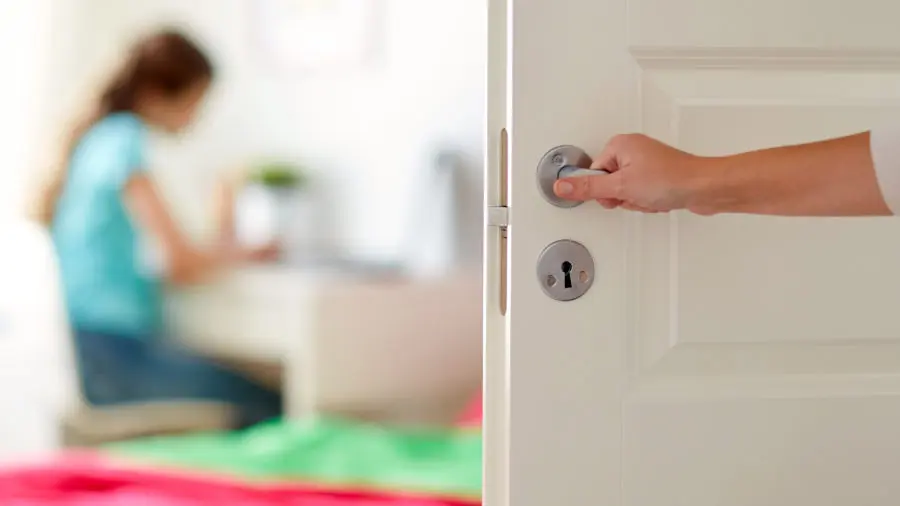If you are thinking about teaching your child or students about sexual education, be sure to read our introductory piece, “Sexual Education for Children with Disabilities” first.
Now that you know how important sexual education is for children, particularly those with disabilities, let’s discuss privacy. Does the child understand the difference between public and private spaces?
If not, this article will explain how to introduce the concept of privacy. This information will be helpful for educators who are covering these topics with students as well as for parents and caregivers who are looking to teach privacy to their children.
Teaching the Concept of Privacy
The concept of privacy is an incredibly complicated subject to teach. One of the most important parts of understanding privacy is understanding and teaching your child that they have control over their body. In order to teach privacy, family members and direct support staff must respect that every individual should consent to who can see or touch their body.
Consent may come in the form of a smile, head nod, a vocal “yes” or a visual communication card. In addition to modeling private activities in the home, begin demonstrating the importance of consent both in language and in interactions. Demonstrating the language of consent will promote advocacy and awareness for your child.
For individuals with exceptionalities who need significant supports to complete daily activities, they may feel so accustomed to someone touching their body without permission that they don’t even see their body as private. In order to teach privacy, all staff must affirm with students that no one can see or touch a student’s body without the student’s consent. Both you as the teacher and any other professional working with the student should explicitly ask for consent before any type of physical contact or prompting.
One way to do this is to verbalize your actions. State your action before placing your hand on the student. Ask your student for his/her consent “Can I…?.” Be on the lookout for any signs of discomfort and if any are detected, move away immediately. Showing students that they have control over their bodies will assist you and reinforce your lessons as you begin teaching about privacy.
Teaching & Establishing Privacy Routines
In addition to consent, begin establishing privacy routines within your classroom. For children with exceptionalities, it’s important to teach them that privacy is when no one can see them. Provide examples and non-examples of private spaces and activities using games, stories, visuals, and videos. Try to include tricky situations such as an empty school bus or public bathroom and explain why these spaces do not indicate privacy and the opportunity for private activities.
To affirm the concept of privacy, always ensure the bathroom door is closed during dressing, hygiene, or bathrooming routines. If you or another staff member is part of the routine, try to ensure as much privacy as possible by turning around while the student voids in the toilet. Never keep the door open and certainly never hold conversations with others during such private encounters. Consider putting a visual on the bathroom door that signals “Privacy” and practice with the students to respond to that signal.
Another way to begin teaching students how to discriminate between public and private activities uses the concept of “open” and “closed”. If a closed-door signals privacy, then an open door would indicate a public space. You can practice students stopping at closed doors and acknowledging when you pass open doors. This provides an opportunity to bring up environmental signals that indicate privacy and private spaces.
Parents & Caregivers: Teaching your child about private parts will help reinforce the concept of public versus private spaces. For example, always close the door during bathroom time and when getting dressed or undressed. Point out how parts of the body belong only to him/her/they. Start to reinforce with your child that when the door is closed, that means someone in the room needs their privacy.
Begin incorporating the idea of privacy into your daily routines. Provide examples and non-examples of privacy and private spaces using stories, visuals, and videos. Consider hanging visuals on the bathroom and bedroom doors to signal the need for privacy (e.g. stop sign means do not come in) and provide your child with praise for following those signs to positively reinforce the lesson.
You can also begin to include household rules regarding privacy. A household rule could include wearing a robe or towel around your body after getting out of the shower or bath. Model this behavior for your child and vocalize what you are doing and why. You can say, “I’m wearing a towel because I need to cover my private parts. I’m going to my room to get dressed because my room is private when I have the door closed.” Consider using picture visuals to facilitate understanding.
Dr. Rachel Schwartz, BCBA-D is an Educational Consultant at the Watson Institute. She received her Master’s Degree in Teaching and Applied Behavior Analysis from the University of Georgia and her Ph.D. in Special Education from the University of Pittsburgh. Dr. Schwartz has worked internationally creating supervising programs for individuals with developmental disabilities and conducts research on the importance of sexual education and expression for individuals with intellectual and developmental disabilities.
